Legendary Iwasa Matabei and his three epic scrolls of tales

A seventeenth-century artist, Iwasa Matabei (1578–1650, aka Katsumochi), enjoyed a successful career as a painter, famous for his characteristic drawing of people with roundish, elongated heads and the unique combination of Japanese and Chinese painting styles. Dubbed “Ukiyo-Matabei,” he was regarded as the father of the ukiyoe culture that flourished later. However, he was also an elusive figure despite his popularity.
Themes for his paintings were wide, from Chinese and Japanese literary classics to contemporary genre paintings, and in particular, his works of scrolls illustrating “jōruri” puppet plays with scripts. This exhibition offers an opportunity to view three of the most renowned scrolls with illustrated jōruri plays: the tales of Yamanaka Tokiwa, of Princess Jōruri, and of Horie. These three works represent Matabei’s heart and soul, forming a body of his masterpieces and invaluable resources to learn about his artistic achievements.
The Tale of Yamanaka Tokiwa tells a story of a young man and his revenge for his mother, who was murdered by a gang of thieves. The liveliness and intensity of the details, it is believed, suggests that Matabei was most deeply involved in the creation of this illustrated work.
The Tale of Princess Jōruri features the same young man and is about his romantic liaison with a daughter of a local influential family. The illustration is particularly lavish with gold, silver, and other expensive color paints.
The Tale of Horie is another story of vengeance, in which a son of the Hories, a powerful clan in north-east Japan, fulfils his revenge against another clan with whom the family fought and perished in a fierce battle. These stories were played in puppet theaters “Jōruri,” which in itself became an established performance art during the Edo period. The scripts that accompany the drawings are invaluable source of information to learn about the history of performing art in Japan.
Illustrated scroll, The Tale of Yamanaka Tokiwa, attributed to Iwasa Matabei, 17th century (Edo period), Important Cultural Property

Chapter 1 (part)
Categorized as the otogi-zōshi-style narrative literature, the Tale of Yamanaka Tokiwa is based on a legendary twelfth-century warrior, Minamoto no Yoshitsune (appears as ‘Ushiwaka’ in the story). He leaves Imperial Kyoto for the northern territory of Japan, and his mother Tokiwa, for the want of seeing her son once again, follows his path but inadvertently falls into the hands of thieves in Yamanaka. Ushiwaka comes to know of his mother’s ill fate and pledges a revenge.
This play was a popular program of puppet theaters during the first half of the seventeenth century. The scroll was likely to have been produced based on an authorized original script of the play. This epic tale consists of twelve chapters (tomes), and the scrolls stretch a total of over 150 m. This series is considered to be the most vibrant and powerful of all narrative scrolls attributed to him, suggesting the artist was most dedicated in the production process. Matabei’s distinctive brushwork is evident throughout, particularly with the excellent depiction of the backgrounds and customs, seen in Chapters 2 and 3. Some scenes are depicted particularly candidly, such as Tokiwa and her lady-in-waiting under attack by the pirates in Chapter 4, and Ushiwaka slaying the culprits in Chapter 9. His genius is also found in the expressions of suspense and emotions through the depiction of props in the scenes. He also leveraged his deep understanding of classical paintings, which shows in the compositions of some scenes.
The cover of the scroll (the very end of the strip) is lined with opulent gold-embroidered fabric on the outer side, and gold-leafed on the inner side. The paper used has a particular chrysanthemum and water flow pattern, and an identical design is found in the rifle instruction book Jiki Yagura, which was signed by daimyo Matsudaira Tadanao, suggesting his involvement in the commissioning of the scroll. The actual year of creation is unknown. Perhaps during the mid-seventeenth century, when the artist lived in Fukui. Alternatively, the late-sixteenth century has been suggested based on the style of the paper decoration and lining. Its provenance extends back to Matsudaira Nobunori, the first lord of Tsuyama Domain (present-day Okayama).
The work came into the public light when the properties of the Matsudaira family were put to auction in 1925, and then a famous publisher Hasegawa Minokichi acquired the scrolls three years later, alarmed that they were otherwise going to be sold to a German collector. Hasegawa thus became a precursor of the social enthusiasm in Iwasa Matabei in the mid-20th century. This work has thus historical value to learn about the life of this somehow elusive artist and his extraordinary paintings.
Illustrated scroll, The Tale of Princess Jōruri, attributed to Iwasa Matabei, 17th century (Edo period), Important Cultural Property
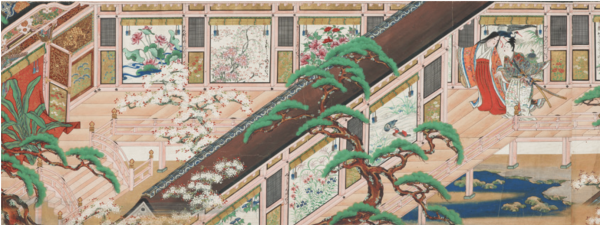
Chapter 3 (part)
The story features the same Ushiwaka from the Tale of Yamanaka Tokiwa and comprises twelve chapters in four parts. The script in the scroll has one part missing. The main theme of the story is a romantic liaison between the young man and Jōruri, a daughter of an influential commoner family in the town of Yahagi. It was a favorite story of the late-sixteenth century, often narrated by blind Buddhists for entertainment. Later, in the seventeenth century, it was adopted as a jōruri puppet play and performed for commoner audiences widely.
The details taken from the script embellish the screens with extraordinary rendition, from Ushiwaka’s costume designs to the interior designs of Jōruri’s maids’ room, the furniture in her bed chamber, and the correspondence between the two young people. This work is considered to be the most opulent and colorful of Matabei’s storytelling scrolls. The artist’s household name characteristics of human figures with elongated roundish heads are the sign that this is the work of Matabei’s atelier, but it is considered to have had less degree of the painter’s involvement, based on the fact that template depiction of human figures is observed in many parts.
Compared to the Tale of Yamanaka Tokiwa, which was created meticulously with all scrolls consisting precisely 13 sheets of paper and script texts and illustrations always matching, the scrolls of the Tale of Princess Jōruri are less organized: different lengths for different scrolls, with some evidence that texts and illustrations were edited in places after the initial completion. These physical differences suggest that the circumstances under which the latter was produced were quite different. Like the former, these scrolls were held by the same Matsudaira family.
Again, the silver-leafed paper holding the core bar has the chrysanthemum and water flow pattern that is identical with the paper of the rifle instruction Jiki Yagura, signed by daimyo Matsudaira Tadanao, suggesting the involvement of the Matsudaira family in the commissioning of the work.
It is believed that it was created in the mid-seventeenth century, but it could possibly be a little earlier, the idea being supported by the scene in Chapter 4, where Princess Jōruri is seated in front of a spread of paper inscribed with lyrics of a sixteenth-century song. There are some similarities in the depiction of people with the folding screen housed in the Tokugawa Art Museum in Nagoya, which allows some insights into the association between the Matabei’s atelier and production of genre paintings.
Illustrated scroll, The Tale of Horie, attributed to Iwasa Matabei, 17th century (Edo period), Important Cultural Property
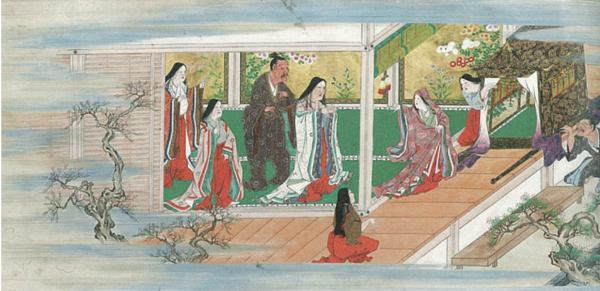
Chapter 6 (part)
The Tale of Horie is another story of vengeance, in which a son of the Hories, a powerful clan in north-east Japan, fulfils his revenge against another clan with whom the family fought and lost lives in a fierce battle. Like the other two tales, this story was played in the jōruri puppet theaters.
The version in the MOA Museum collection comprises twelve chapters (scrolls) in total, and there are similar illustrated scrolls of the same plot known to exist, with four scrolls and a fragment of drawing. Together, it is estimated that the original work may have been an epic narrative of twenty chapters. Some scenes look extremely similar between the two examples of the Tales of Horie, but the version held by the MOA Museum of Art has remarkably fewer illustrations, each of which are also shorter in length, than the extant incomplete set of four scrolls. The conventional theory holds that the Museum’s collection is an abridged version of an original, fuller work, attributed to the other set. However, details do not necessarily support this theory, indicating complexity of contextual descriptions behind the production of these scrolls.
The attribution to Matabei is based on characteristic features observed in the illustrations: the oblong faces, rather long limbs with back-bending extremes, and the use of vivid colors and decorative designs. In the twelve chapters, violent and savage scenes appear repeatedly, depicting battles and slaughters, which resembles the characteristics of the Tale of Yamanaka Tokiwa. The calligraphic handwriting is extremely similar to that seen in the Tales of Princess Jōruri, suggesting close relevance between the two works.
Documentations exist to verify the first theatrical performance, but the original script has not been discovered to this day. Therefore, the twelve-chapter version at the Museum is a valuable artifact to reveal the narrative. The roll-end paper is lined with a gold-embroidered fabric, bearing a design of phoenix among floral arabesque. Inside, the gold-leafed paper is decorated with a fan-shaped window with an ink wash painting. Its creation is estimated to be the mid-seventeenth century, and its provenance is unknown.
◆展示目録はこちら重要文化財 山中常盤物語絵巻 伝 岩佐又兵衛勝以 江戸時代(17世紀)
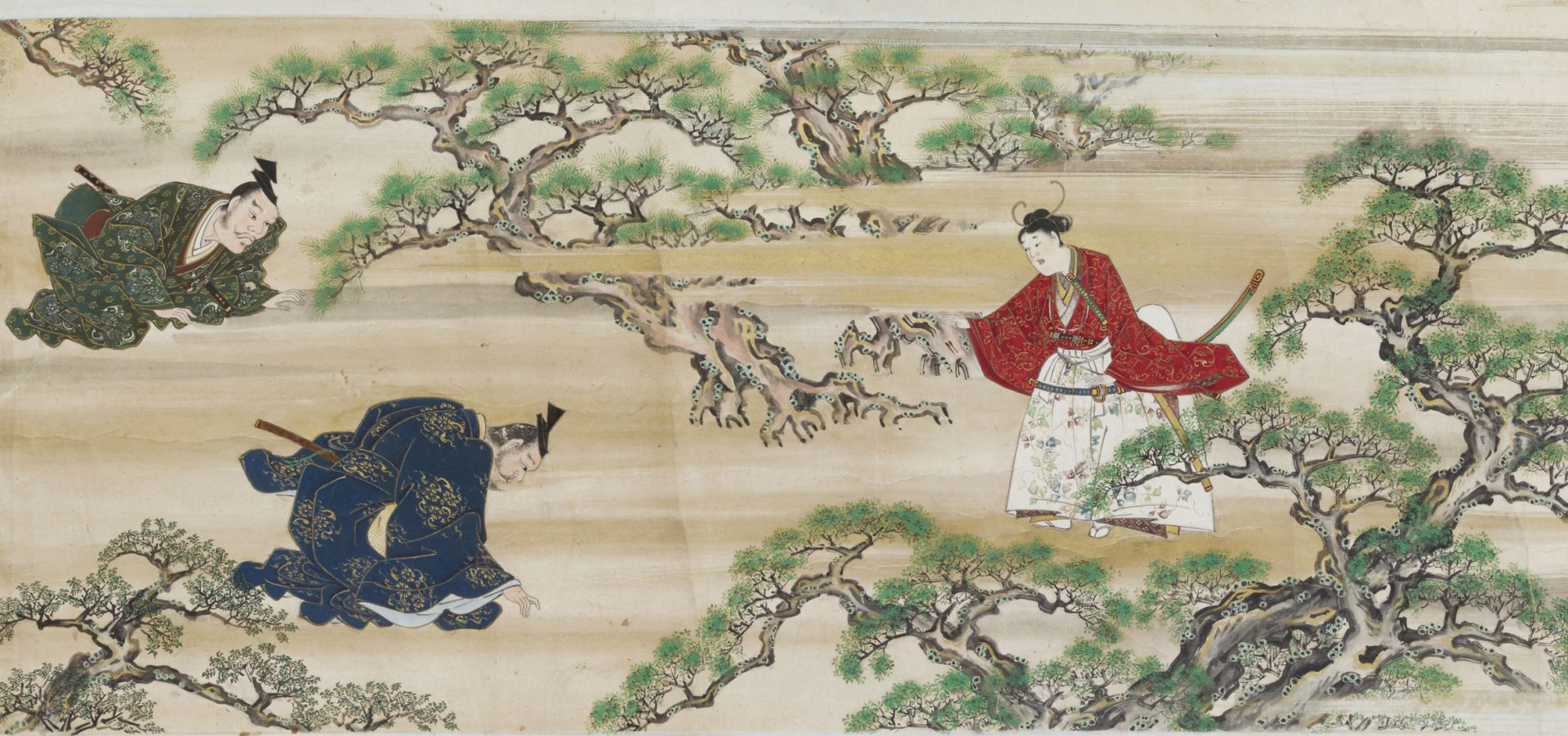
第1巻(部分)
『山中常盤物語』は、義経伝説に基づく御伽草子系の物語で、奥州へ下った牛若を訪ねて都を旅立った母の常盤御前が、山中の宿で盗賊に殺され、牛若がその仇を討つという筋書きである。慶長(1596-1615)・元 和(1615-1624)・寛 永(1624-44)にかけて、操浄瑠璃の一つの演目として盛んに上演され、本絵巻は、その正本(テキスト)にもとづいて制作されたものと考えられている。12巻からなり、全長は150メートルを超える長大な作品である。本作品は、又兵衛が描いたとされる絵巻物群の中で、最も生気あふれる力強い作風で、又兵衛自身の関与が最も高いと考えられている。特に、巻2・3の常盤主従の道行きの場面などの自然や風俗の描写は巧みで、又兵衛の技量の高さを感じさせる。巻4の常盤主従が盗賊に襲われ殺される場面や巻9の牛若が八面六臂の活躍によって盗賊たちに仇討ちをする場面など、凄惨な場面の鮮烈な描写は本図の特色となっている。巻4の常盤が刺される場面では、描かれた松樹が激しくうねりを見せ、次の場面では、ぐったりとうなだれて表されるなど、場面の緊張感や人物の感情を、景物に託して描いている。また、古典絵画から図様を転用した場面が幾つか指摘されており、又兵衛の古典絵画への深い造詣が窺われる。絵巻の表紙は、唐獅子模様を織り出した豪華な金襴で、見返しは金箔である。軸付紙の菊花流水空押し文様のある料紙が、越前藩主であった松平忠直の署名がある稲富流鉄砲伝書『直矢倉之巻』にも用いられていることから、本絵巻の制作にあたり越前松平家が関与していたことが想定される。制作時期は、又兵衛の福井在住期である元和末年から寛永初年頃と推定されているが、料紙装飾や装丁の面から慶長後半から元和初年頃まで引き上げる説もある。越前藩主松平忠直の子光長の養子宣富が封ぜられた津山藩主松平家に伝来したもので、大正14年5月の東京美術倶楽部による松平子爵家蔵品売立によって世に出た。昭和3年、ドイツへ売られるところを引き止めた第一書房社主長谷川巳之吉によって広く紹介され、昭和の又兵衛論争を引き起こすきっかけとなった。江戸時代初期の異色の絵巻として、また岩佐又兵衛の画業を考える上でも重要な作品である。重要文化財 浄瑠璃物語絵巻 伝 岩佐又兵衛勝以 江戸時代(17世紀)
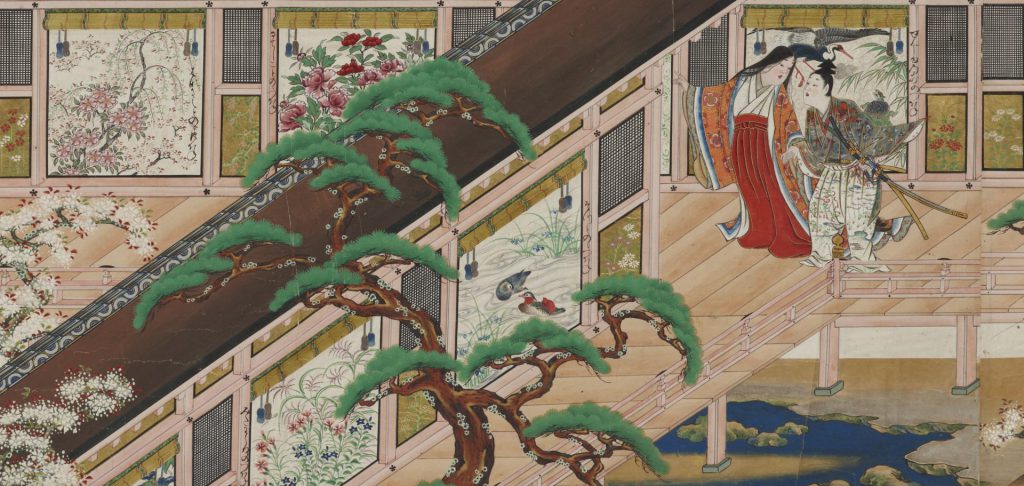
第3巻(部分)
「山中常盤物語絵巻」同様、牛若を主人公にした古浄瑠璃の正本(テキスト)を詞書とし、その内容を絵画化した12巻の絵巻である。詞書本文は、「申し子」「矢矧」「吹上」「五輪砕」の四部のうち、「申し子」を欠くもので、奥州に下る牛若と三河矢矧の長者の娘浄瑠璃との恋愛譚を中心にした内容である。中世末期には浄瑠璃節として、盲目の法師によって盛んに語られ、都では周知の物語であったようである。近世に入り、慶長の頃には操浄瑠璃と結びついて熱狂的な人気を博した。『浄瑠璃物語』の正本をそのまま用いた詞によって、牛若の衣裳模様や女房たちの局の襖の画題、浄瑠璃姫の寝室の調度、二人が交わす大和言葉の逐一まで事細かに語られ、それらの場面が、金箔・金銀泥・緑青・群青・朱など各種の高価な顔料を使い、艶麗な色調で細微に描かれている。又兵衛筆とされる絵巻群中、最も色彩の華麗な絢爛豪華な作品である。豊頬長頤の特徴をもつ人物の姿形などから又兵衛工房による制作と推測されるが、「山中常盤」に較べて全体に人物の描写が類型的であり、「山中常盤」よりも、又兵衛が制作に関与した度合いは低いと思われる。「山中常盤」の全ての巻が13紙からなり、詞と絵が当初から緊密に組み合わされ計画的に制作されているのに対し、「浄瑠璃」各巻の紙数は揃っておらず、詞書・絵とも完成後に継ぎ合わせている箇所が見られることから、両者の制作事情の違いが推測される。「山中常盤」と同様、越前藩主松平忠直の子光長の養子宣富が封ぜられた津山藩主松平家に伝わった。越前藩主であった松平忠直の署名がある稲富流鉄砲伝書『直矢倉之巻』に用いられている菊花流水空押し文様が、「浄瑠璃」の銀箔地の軸付紙に空押しされていることからも、本絵巻制作における越前松平家の関与が想定される。制作時期は、寛永末年から正保(1645-48)・慶 安(1648-51)頃と推定されているが、巻4の浄瑠璃姫の前に拡げられた巻紙に書き込まれた隆達節の流行時期を考慮し、制作年代を元和年間頃まで引き上げて考えるべきとする説も提出されている。 「浄瑠璃」の人物の顔貌・姿態と金銀泥を多用した濃密な彩色は、「豊国祭礼図屏風」(徳川美術館)との共通点が多く、又兵衛工房と風俗画との関係を考える上でも重要な作品である。堀江物語絵巻 伝 岩佐又兵衛勝以 江戸時代(17世紀)
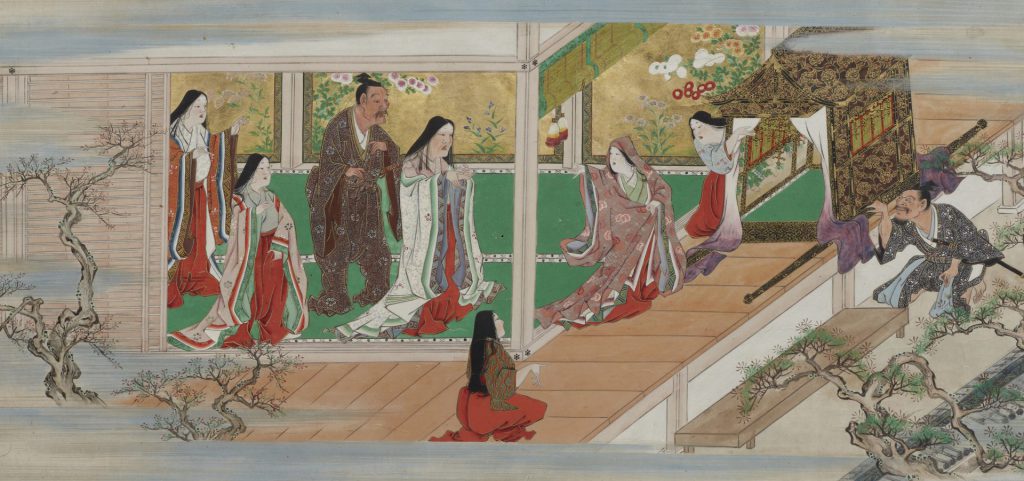
第6巻(部分)
「堀江物語絵巻」は、下野の豪族、堀江三郎の子、月若が、豪族間の紛争によって非業の死を遂げた父母の仇討ちを果たし、堀江氏の再興を果たす物語で、「山中常磐物語絵巻」や「浄瑠璃物語絵巻」と同じく、操浄瑠璃などで上演されていたものを絵巻物にしたものである。MOA美術館が所蔵する「堀江物語絵巻」は十二巻で完結するが、これとほぼ同じ詞書を用いた絵巻が別にあり、現在4巻分と断簡1図が知られている。MOA本をもとに当時の姿を推測すると、もともとは全二十巻に達する膨大な力作であったと推定される。両者には、図様が一致する場面はいくつかあるものの、MOA本は、残欠本より挿図の数が少なく、特に一図の長さが相当短くなっているのが目立つ。このことからMOA本は残欠本をもとに十二巻に縮小し仕立てられたものとされてきた。しかし、古典絵画からの転用のあり方や詞書の異同などを見ると、必ずしも残欠本を元にMOA本が制作されたと断定出来ない面もあり、制作過程は複雑である。装飾性の強い彩色や、豊頬長頤の風貌、手足の先の反り返った人物描写の特徴などから、又兵衛工房作と見られている。十二巻中には、繰り返し凄惨な合戦場面や惨酷な殺戮場面が描かれ、この傾向は、「山中常盤」にも共通し、又兵衛筆とされる古浄瑠璃の絵巻物の特徴である。人物描写にやや硬く類型化が見られる点は「浄瑠璃」と近く、詞書も「浄瑠璃」と同一筆者と思われることから、両者には密接な関係があると推測される。観劇記録によって、『堀江物語』が古浄瑠璃として上演されたことが知れるが、浄瑠璃本は確認されておらず、MOA本の詞書のみによって作品内容を知ることができ、芸能資料としても貴重である。唐草に鳳凰の模様ある金襴の表紙に「堀江巻雙紙」と外題があり、各巻見返しの金箔地には、胡粉で扇面が描かれ、そこに水墨画が描かれている。制作年代は、残欠本より下る慶安年間頃とされる。第二次世界大戦後に世に出たもので、伝来については未詳である。 展覧会目録はこちら